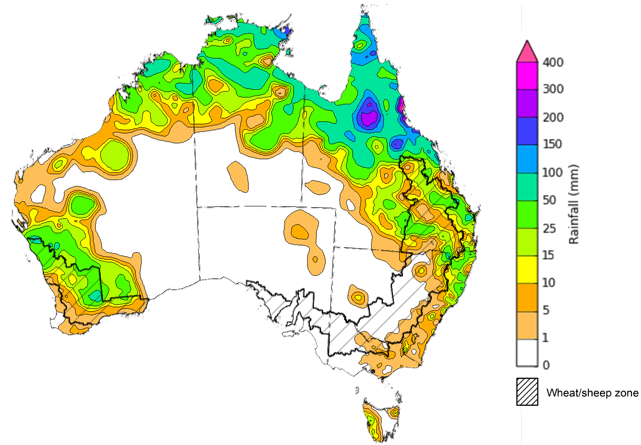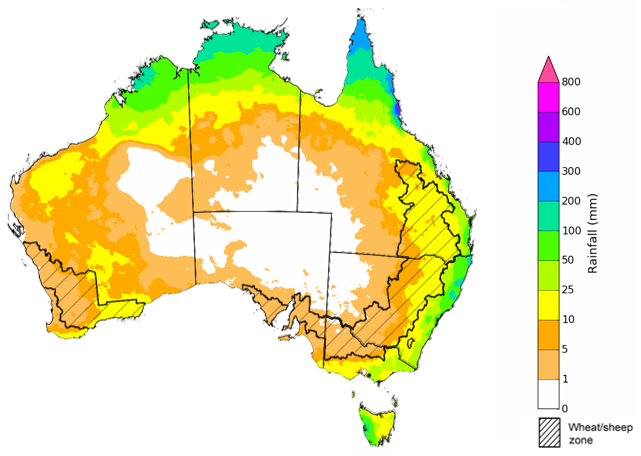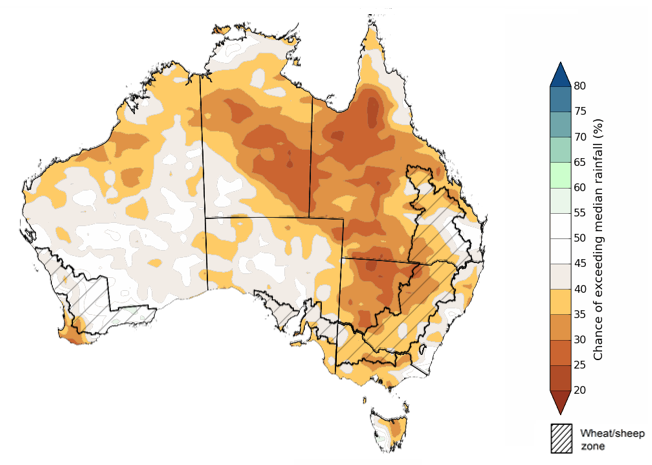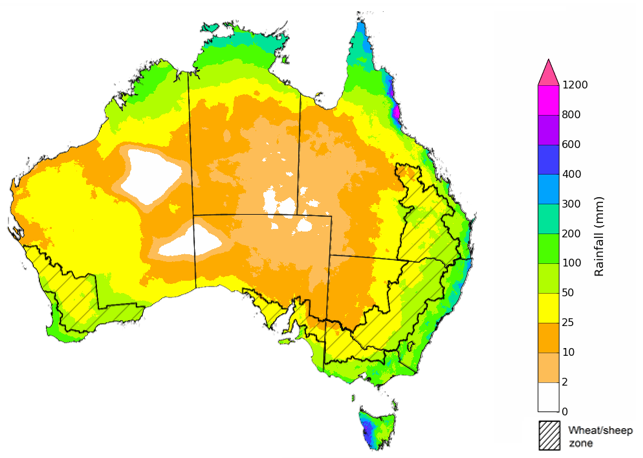Key issues
- In the week ending 28 February 2024, ex-Tropical Cyclone Lincoln generated heavy rainfall in Western Australia’s Kimberley region. South-western parts of Western Australia also benefitted from the heavy rainfall, after being dry for several months. Showers and storms were recorded in the tropics, extending to coastal east New South Wales.
- Over the coming days, widespread storms and showers is forecast for much of northern Australia and Western Australia. Southerly onshore winds will bring showers to coastal New South Wales and Queensland. A cold front will bring showers to the western Tasmania.
- Rainfall in Queensland and New South Wales will continue to support development of summer crops and pasture growth.
- If realized, forecast rainfall across Western Australian cropping regions will provide some boost to soil moisture levels following several months of dryness. However, more rainfall in autumn will be required in these areas to support the planting of winter crops.
- Autumn 2024 rainfall is likely to be below median across much of northern and eastern Australia. There is 50% chance of rainfall being above median across parts of southern Western Australia.
- Water storage levels in the Murray-Darling Basin (MDB) decreased between 21 February 2024 and 28 February 2024 by 173 gigalitres (GL). Current volume of water held in storage is 18 103 GL, equivalent to 84% of total storage capacity. This is 12 percent or 2493 GL less than at the same time last year.
- Allocation prices in the Victorian Murray below the Barmah Choke increased from $22 on 22 February 2024 to $25 on 29 February 2024. Prices are lower in the Murrumbidgee and regions above the Barmah choke due to the binding of the Murrumbidgee export limit and Barmah choke trade constraint.
Climate
For the week ending 28 February 2024, ex-Tropical Cyclone Lincoln generated heavy rainfall in Western Australia’s Kimberley region. South-western parts of Western Australia also benefitted from the heavy rainfall, after being dry for several months. Showers and storms were recorded in the tropics, extending to coastal eastern New South Wales. A high-pressure system kept central and southern parts of the country dry.
Across cropping regions, rainfall totals of up to 100 millimetres were recorded across northern and eastern parts of Western Australia. While these falls have likely provided some relief from months of dry conditions in Western Australia cropping regions, follow-up falls will be required to build moisture levels prior to the planting of winter crops. Rainfall totals of up to 50 millimetres were recorded in Queensland. These falls will continue to support the ongoing growth and lift the yield potential of summer crops. Additionally, these falls will help maintain soil moisture levels to support pasture growth and build reserves ahead of the upcoming winter cropping season. By contrast, South Australia, and Victoria and New South Wales remained dry.
Rainfall for the week ending 28 February 2024
Issued: 28/02/2024
Note: The rainfall analyses and associated maps utilise data contained in the Bureau of Meteorology climate database, the Australian Data Archive for Meteorology (ADAM). The analyses are initially produced automatically from real-time data with limited quality control. They are intended to provide a general overview of rainfall across Australia as quickly as possible after the observations are received. For further information go to http://www.bom.gov.au/climate/rainfall/
Over the 8 days to 7 March 2024, widespread storms and showers is forecast for much of northern Australia and Western Australia. Southerly onshore winds will bring showers to coastal New South Wales and Queensland. A cold front will bring showers to the western Tasmania. A high-pressure system would keep much of the remainder of Queensland and New South Wales, and Victoria and South Australia mainly dry.
Across cropping regions, rainfall totals up to 25 millimetres are forecast for Queensland and northern New South Wales. If realised, these falls will continue to benefit soil moisture levels for pasture growth and support the growth of long season and later sown summer crops in Queensland and New South Wales. With the harvest of early planted summer crop now underway, wet weather over the next 8-days is likely to result in some harvest delays. For the second week in a row Western Australia is expected to receive up to 50 millimetres of rainfall. After several dry months, however, more is required to prepare the sub-soil with sufficient moisture for the winter crops.
Little to no rainfall is expected across remaining cropping regions.
Total forecast rainfall for the period 29 February to 7 March 2024
Issued 29/02/2024
Note: This rainfall forecast is produced from computer models. As the model outputs are not altered by weather forecasters, it is important to check local forecasts and warnings issued by the Bureau of Meteorology.
The Bureau of Meteorology’s latest rainfall outlook for March 2024 indicates that rainfall is likely (60 to 80% chance) to be below median across much of central Australia. Above median rainfall is likely in southern parts of Western Australia and northeastern New South Wales. Equal chances of below or above median rainfall is likely elsewhere.
The Bureau of Meteorology’s climate model suggests that for March 2024, there is a 75% chance of rainfall totals being over 25 millimetres across coastal east and northern Australia, as well as in western Tasmania and southern Victoria. Rainfall totals in excess of 100 millimetres are expected northern Queensland and Northern Territory.
Across cropping regions, there is at least a 75% chance of rainfall totals up to 25 millimetres in Queensland and parts of northeastern New South Wales, and southern Western Australia. March rainfall totals are expected to be below 10 millimetres for the remaining cropping regions.
If realised these forecast rainfall totals for March will provide some useful follow-up falls for dryland summer crop production as well as pasture growth across eastern and northern Australia.
Rainfall totals that have a 75% chance of occurring in March 2024
Issued: 29/02/2024
For further information, go to http://www.bom.gov.au/climate/ahead/about/
The 2023 El Niño continues to weaken. The rainfall outlook for March to May 2024 suggests that there is least a 50% chance of exceeding median rainfall across much of Western Australia and South Australia, and in scattered areas in the eastern Australia and Western Tasmania. Below median rainfall is likely remaining Australia.
Across cropping regions, 50% chance of exceeding median rainfall is likely in many growing regions.
Chance of exceeding the median rainfall March to May 2024
Issued: 29/02/2024
The outlook for March to May 2024 suggests there is at least a 75% chance of rainfall totals above 25 millimetres across much of Australia. The main exceptions being large areas of the interior where below 25 millimetres of rainfall are expected. Rainfall totals in excess of 200 millimetres are likely across tropical northern Australia, along Australia’s eastern coastline and western Tasmania during this period.
Across cropping regions, there is at least a 75% chance of receiving 25 millimetres or more.
If realised, these falls will likely be sufficient to support autumn pasture growth across eastern and northern Australia and growth late planted summer crops. These falls are also likely to be sufficient to support the early planting of winter crops across those areas of eastern Australia that have benefited from above average summer rainfall and an associated boost to soil moisture profiles.
Rainfall totals that have a 75% chance of occurring March to May 2024
Issued: 29/02/2024
Water
Water storages, water markets and water allocations - current week
The Tableau dashboard may not meet accessibility requirements. For information about the contents of these dashboards contact ABARES.
Commodities
Information on weekly price changes in agricultural commodities is now available at the Weekly commodity price update.





